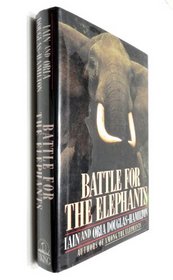Helpful Score: 1
From Library Journal
Two of the world's leading elephant authorities tell a gripping story of unrelenting slaughter, corruption, complex politics, and the first signs of hope. While the world has only recently become fully aware of the devastation of the African elephant population and the role of the ivory trade, the Douglas-Hamiltons have spent decades performing censuses, writing books and articles, giving speeches, and even taking up arms to fight for this magnificent animal. The book is not about biology but about elephant politics, including corruption to the highest levels in governments, misjudgment by some conservation groups, civil wars financed with ivory, and, fortunately, enough honest officials and good judgment to make a difference. Anyone interested in the plight of the elephants should read this book. Highly recommended for all collections.
From Kirkus Reviews
An understandably partisan account by the Douglas-Hamiltons (Among the Elephants, 1975) of how they fought to get ivory banned worldwide. Recalling their first visits to Manyara Park in Tanzania in the late 1960's, when the problem seemed more a surfeit of elephants, the husband-and-wife authors relate how, 20 years later, elephants were being killed by the thousands to satisfy the burgeoning market for ivory in the Far East. In Manyara itself, the number of surviving elephants had declined from 500 to 181, and a similar pattern prevailed, they soon learned, throughout Africa, with the exception of Southern Africa. Often in personal danger as planes ran out of fuel, crashed, or came under gunfire in war-torn Uganda, the couple saw horrifying scenes of wanton mutilation and killing in the preserves--''wounded stragglers dragging their shattered legs''; ``the bodies of the fallen [with] the meat intact but the tusks gone''; and ``a skeleton of a six year old still intact except for the skull which had been hacked to remove its cigar-sized tusks.'' Sickened by the sights and alarmed at what was rapidly becoming an elephant genocide, the Douglas-Hamiltons launched a crusade to stop the ivory trade. Initially, funds were few; international conservation movements skeptical; and many African leaders, involved in the lucrative trade themselves, obstructive--but the authors persevered, and won: In 1989, the ivory trade was declared illegal throughout much of the world. The Douglas-Hamiltons gloss over the problems of Africa that fuel much of the situation they decry, but, still, they offer an eloquent account of a great battle waged on behalf of a noble and worthy creature.
Two of the world's leading elephant authorities tell a gripping story of unrelenting slaughter, corruption, complex politics, and the first signs of hope. While the world has only recently become fully aware of the devastation of the African elephant population and the role of the ivory trade, the Douglas-Hamiltons have spent decades performing censuses, writing books and articles, giving speeches, and even taking up arms to fight for this magnificent animal. The book is not about biology but about elephant politics, including corruption to the highest levels in governments, misjudgment by some conservation groups, civil wars financed with ivory, and, fortunately, enough honest officials and good judgment to make a difference. Anyone interested in the plight of the elephants should read this book. Highly recommended for all collections.
From Kirkus Reviews
An understandably partisan account by the Douglas-Hamiltons (Among the Elephants, 1975) of how they fought to get ivory banned worldwide. Recalling their first visits to Manyara Park in Tanzania in the late 1960's, when the problem seemed more a surfeit of elephants, the husband-and-wife authors relate how, 20 years later, elephants were being killed by the thousands to satisfy the burgeoning market for ivory in the Far East. In Manyara itself, the number of surviving elephants had declined from 500 to 181, and a similar pattern prevailed, they soon learned, throughout Africa, with the exception of Southern Africa. Often in personal danger as planes ran out of fuel, crashed, or came under gunfire in war-torn Uganda, the couple saw horrifying scenes of wanton mutilation and killing in the preserves--''wounded stragglers dragging their shattered legs''; ``the bodies of the fallen [with] the meat intact but the tusks gone''; and ``a skeleton of a six year old still intact except for the skull which had been hacked to remove its cigar-sized tusks.'' Sickened by the sights and alarmed at what was rapidly becoming an elephant genocide, the Douglas-Hamiltons launched a crusade to stop the ivory trade. Initially, funds were few; international conservation movements skeptical; and many African leaders, involved in the lucrative trade themselves, obstructive--but the authors persevered, and won: In 1989, the ivory trade was declared illegal throughout much of the world. The Douglas-Hamiltons gloss over the problems of Africa that fuel much of the situation they decry, but, still, they offer an eloquent account of a great battle waged on behalf of a noble and worthy creature.




